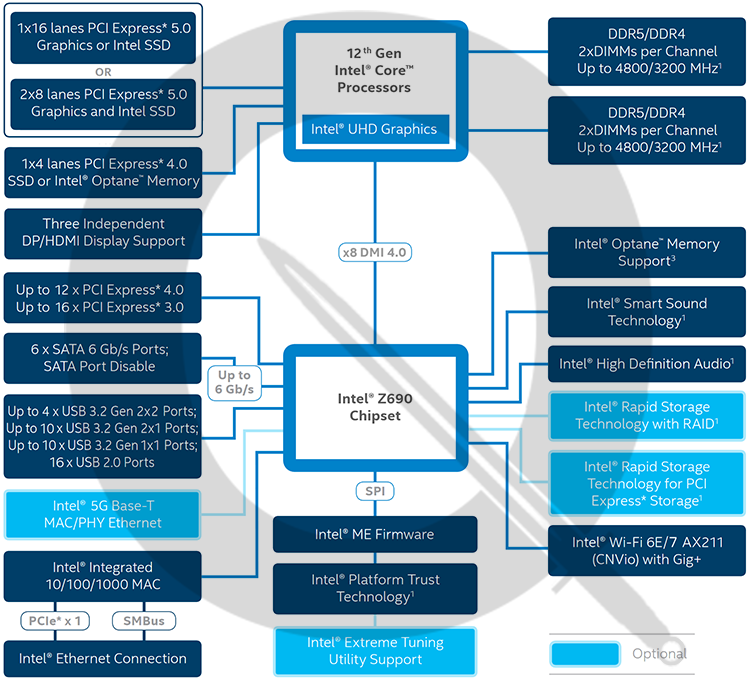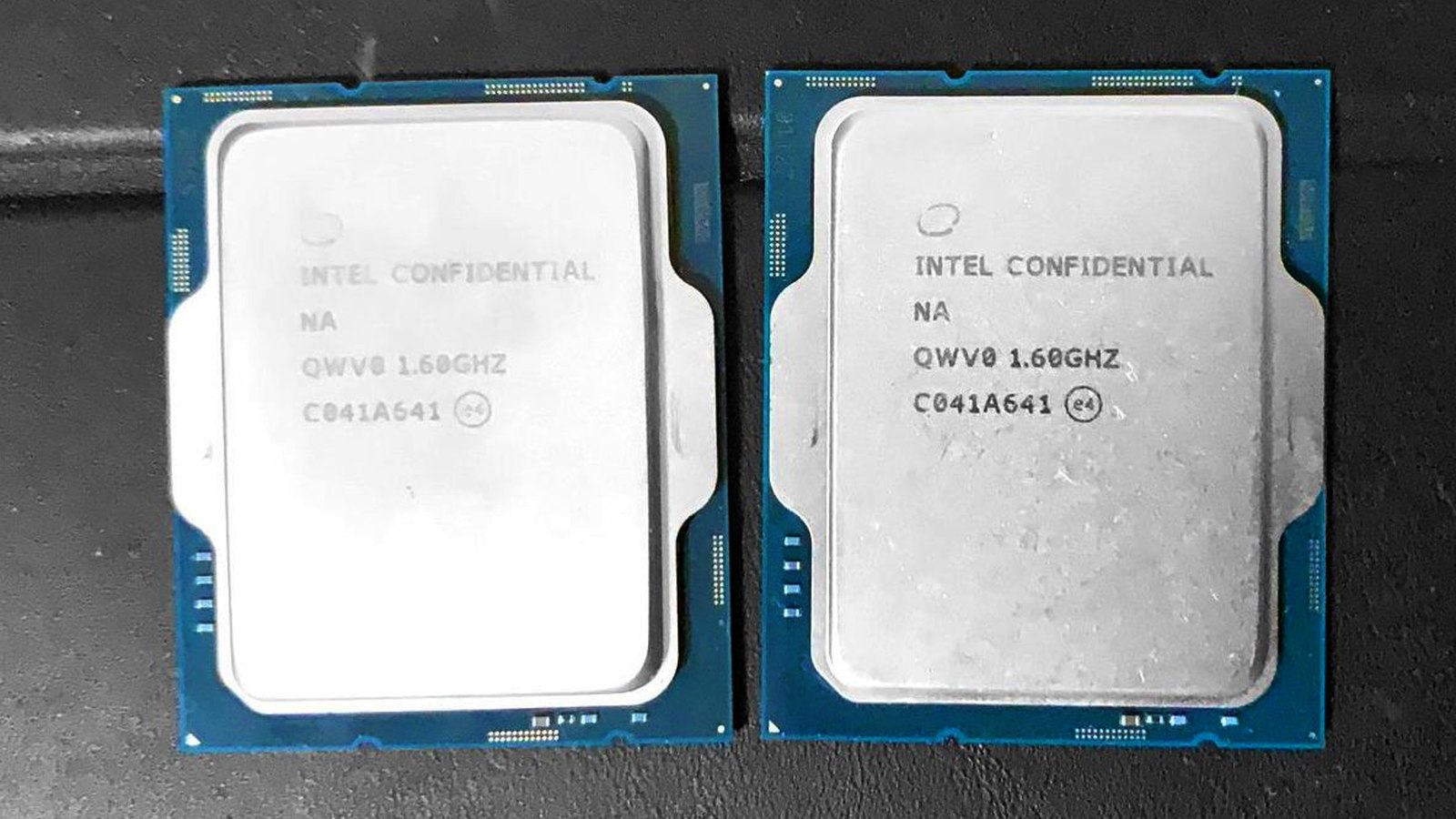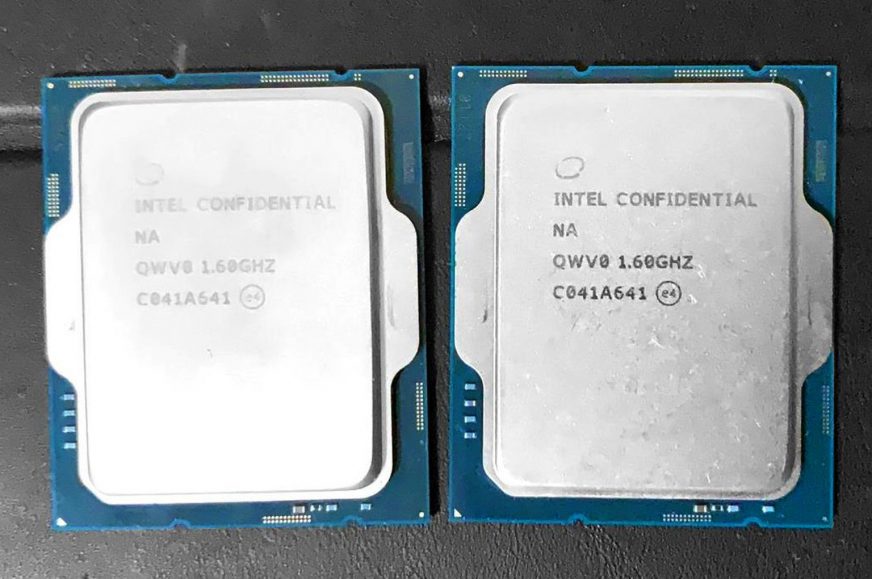Connectivity and features diagram of the Z690 chipsed leaked
Alder Lake, a new and significantly improved CPU generation by Intel will be released in a few months (reportedly on 19th of November). The CPUs will be released together with new motherboards using the Z690 chipset and the new LGA 1700 socket. A document leak now shares insight into the features and innovations of this platform. For example we learn that Alder Lake’s memory controller will also use Gear 2 and now even Gear 4.
The PC Inquisitor website has shown a photo of the bottom side of the Alder Lake CPU for desktop (this has added to several similar pictures that have already appeared on the internet previously, so this is not a new information) but also a schematic diagram of the platform and chipset, likely from Intel’s NDA documents.
PCIe 5.0 for graphics, just PCIe 4.0 for SSDs
The platform connectivity diagram has confirmed some of the previously discussed nuances of Alder Lake. The CPUs will support PCI Express 5.0, namely 16 lines for GPU, which will be optionally divisible into ×8/×8 – a ×8/×4/×4 division has not been mentioned. It is also confirmed that PCI Express 5.0 will not be provided for SSD. The platform scheme reveals that in the case of NVMe SSD in M.2 slots, only PCI Express 4.0 ×4 will be provided to link them to the CPU.
For SSDs (and other peripherals in PCIe slots) the chipset will provide additional PCI Express 4.0 lines, up to the number of 12, the motherboard therefore could possess up to four M.2 slots with PCIe 4.0 connectivity. Further 16 PCI Express 3.0 lines will be available, ensuring the PCIe 4.0 lines will not be consumed by less important slots and add-on controllers.
The Z690 chipset will be linked to the processor with great bandwidth by means of the DMI 4.0 ×8 interface which corresponds with PCI Express 4.0 ×8. Compared to Intel Z490 or AMD B550, this achieves four times higher bandwidth and compared to AMD X570 and Intel Z590 the bandwidth still raises twice. (AMD achieves this level of bandwidth between CPU and chipset only with the TRX40 platform). It appears, that Alder Lake and Z690 will be able to hold on to this advantage even against the AMD AM5 platform with Ryzens 6000/7000. The latter will, according to the leaked scheme, maintain merely a PCIe 4.0 ×4 connectivity between the chipset and the CPU (additionally the GPU slot will be just PCIe 4.0 ×16, on the other hand the CPU will be able to use two PCIe 4.0 ×4 interfaces for SSD instead of one).
DDR5, DDR4 and the new Gear 4 memory controller
A further confirmed fact is that the Alder Lake, in the LGA 1700 socket on the Z690 platform will be able to utilise DDR5 memory modules, this however will not be a necessity. DDR5-4800 or DDR4-3200, both with two modules pre channel, are supported. Although it is possible that the maximum frequency will not be officially supported on all CPUs (but if so, they likely will be achievable unofficially). You will have the choice of buying new DDR5 memory with a high bandwidth, or you can save money by settling with the present DDR4 modules – motherboards for DDR5 as well as models for DDR4 will be offered.

Another substantial piece of information: Similarly to the Rocket Lake CPUs, the memory controller will utilise dividers, that Intel calls “Gear”. What does it mean? Starting with a particular memory clock the divider on Rocket Lake should switch from the 1:1 mode (the frequency is identical to the clock of the memory, or to be more precise half of the effective clock of the memory due to DDR signalling), which is Gear 1, instead dropping to the Gear 2 mode, where the memory controller clock is cut in half compared to the memory clock. This allows for the frequency of the memory to be scaled higher. Even though Gear 1 can also be enabled for configurations, where Intel already recommends Gear 2, doing as such raises the uncore’s power consumption (and beyond a certain point, this can introduce instability).
Alder Lake will either have the same or a similar memory controller and Gears 1 and 2 will also be used. What is new is that in case of DDR5 even Gear 4 will be utilised, this should lower the frequency of the memory divider down to a fourth compared to the effective memory frequency. This seems reasonable, since DDRs have a significantly higher effective clock. So far we do not know, at which frequency will Gear 4 will start to be necessary (or recommended), however it is possible that Gear 2 will always be required for DDR5-4800 already.
A downside of Gear 2 is the fact, that it typically worsens the memory latency. Therefore utilising the highest frequency still operating with Gear 1 might be more rewarding for a gaming PC than going to memory with higher clock but Gear 2. Gear 4 might similarly contribute only to raising of the bandwidth, while again worsening the latency.
What other new features will the platform provide? The Z690 chipset will neither support USB4 nor Thunderbolt 4, for now this still will be handled by using an additional controller. As well as the previous Z590 chipset, this platform will also support USB 3.2 Gen 2×2 (or SuperSpeed USB 20Gbps) connectivity, while being able to offer four ports instead of the Z590’ three. Up to ten USB 3.2 Gen 2 (SuperSpeed USB 10Gbps) can be connected to the chipset. No changes will happen in regards to SATA connectivity, this will remain a total of six ports.

Wi-Fi 7 with Intel Wireless AX211
Intel will support the addition of 1Gb/s or 5Gb/s Ethernet, but the chipset will also have a digital part of Wi-Fi/Bluetooth wireless adapter integrated. For it to work an analog (RF) module will have to be connected via the special proprietary CNVio interface. The Z690 chipset will support the new generation of wireless adapters to be added this way, AX211.
AX211 will allow for Wi-Fi 6E and for the new Wi-Fi 7 (802.11be) as well. Wi-Fi 7 has not been standardised so far, it likely will utilise the 2,4GHz, 5GHz and 6GHz ranges, up to 16× MIMO and up to 320MHz channel width, likely together with the 4096-QAM modulation. Which parts of this standard’s scope and what theoretical speed the AX211 adapter will support is not known yet.

With these additional functions you should remember that not all motherboards will utilise all of them. In regards to ports and connectivity present directly in the chipset, generally particular mainboards will not always expose all available USB ports and PCI Express lines, that can be seen in the diagram. However the chipset in itself seems to enjoy an advanced connectivity and paired with the PCIe 5.0 and 4.0 connectivity provided by the CPU, it should allow for the production of motherboards with very rich functionality that will be able to satisfy even the users who previously had to turn to the „HEDT“ segment.
- Tip: Intel Alder Lake/Golden Cove CPU core unveiled (µarch analysis)
- Tip: Gracemont, the (not so) little Alder Lake core (µarch analysis)
- Tip: Big.LITTLE in Alder Lake works thanks to the Thread Director technology
What will be interesting to watch out for is whether the inclusion of PCIe 4.0 and the usage of PCIe 4.0 ×8 for the connection to the CPU has increased the power consumption. Although Intel’s experience could enable a lower power usage than AMD’s X570 chipset. Even though it is also possible that Intel will simply not be too concerned about it, similarly as the company currently doesn’t seem to focus much on keeping TDPs and PL2 power limits of processors low.
source: PC Inquisitor, Via: VideoCardz
English translation and edit by Karol Démuth, original text by Jan Olšan, editor for Cnews.cz








